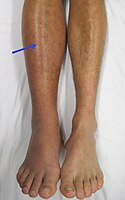
Photo from wikipedia
Pulmonary embolism (PE) is a significant contributor to morbidity and mortality in the United States. Catheter-directed, ultrasound-assisted thrombolysis (USAT) uses high-frequency, low-energy ultrasound waves to disaggregate uncrosslinked fibrin fibers and… Click to show full abstract
Pulmonary embolism (PE) is a significant contributor to morbidity and mortality in the United States. Catheter-directed, ultrasound-assisted thrombolysis (USAT) uses high-frequency, low-energy ultrasound waves to disaggregate uncrosslinked fibrin fibers and increase thrombus penetration of a locally delivered thrombolytic to treat an acute PE. The purpose of this study is to compare the efficacy and safety of catheter-directed USAT versus systemic anticoagulation alone in submassive PE. This was a single-center, retrospective study of patients with a diagnosis of acute submassive PE from April 4, 2014 to May 1, 2019 at a large, academic medical center. Subjects were split into two different groups based on treatment with either USAT with systemic anticoagulation or systemic anticoagulation alone. The primary outcome was the incidence of severe or life-threatening GUSTO bleeding within 72 h or until hospital discharge if sooner. A total of 130 subjects were included (n = 40 in the USAT group and n = 90 in systemic anticoagulation alone group). Significantly fewer subjects in the USAT group had an active diagnosis of cancer at the time of presentation (7.5% vs 28.9%, p = 0.006). There was no difference in severe or life-threatening GUSTO bleeding or any component of the GUSTO bleeding definitions. Administration of USAT with systemic anticoagulation was well-tolerated when compared to systemic anticoagulation alone, but bias may have led to selection of patients for USAT with a lower bleeding risk and higher functional status at baseline.
Journal Title: Journal of Thrombosis and Thrombolysis
Year Published: 2020
Link to full text (if available)
Share on Social Media: Sign Up to like & get
recommendations!